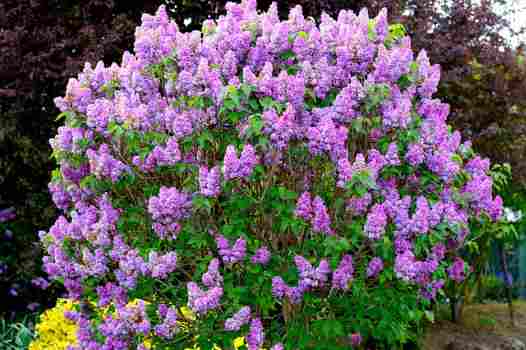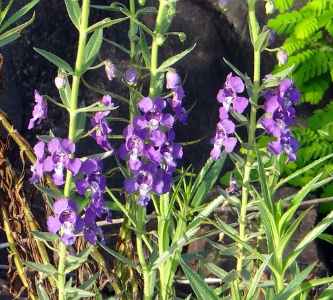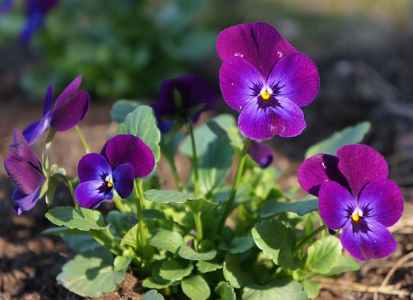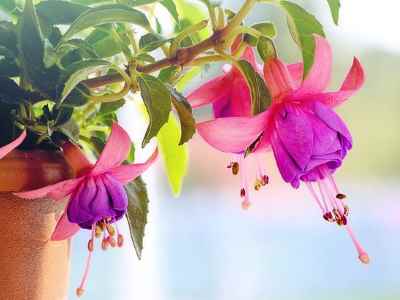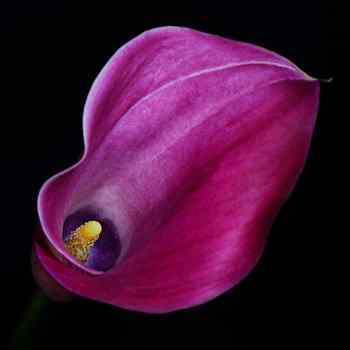Purple Flowers to Give Stunning Color to Your Garden (With Pictures) – Identification Guide
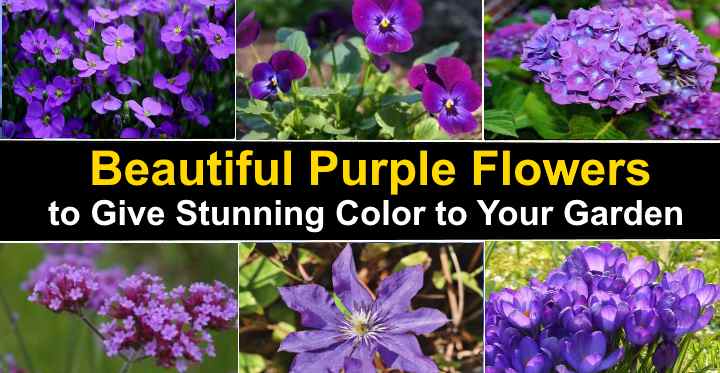
Purple flowers are some of the most popular flowers for gardens. Flowers in shades of purple from light lilac to mauve and deep violet are beautiful to look at. Many types of purple flowering plants such as lavender, pansies, petunias, and verbena contrast well with light green foliage. Purple flowers also look great alongside white flowers, pink flowers, or yellow blooms.
The color purple has always been associated with royalty, wealth, and luxury. Purple flowers can mean success, accomplishment, and transition in life. For example, purple flowers are common gifts to wish success for an engagement or starting a new job.
If you want to decorate your garden with pretty purple flowers, then it’s good to remember a few things. Shrubs, plants, and bushes with purple flowers generally need a lot of sun to thrive. Also, the soil should be well-draining and not overly soggy or dry.
Types of Purple Flowers (With Pictures and Names) – Plant Identification Guide
Read on to learn about some of the best and most popular flowers for your garden. This following list of purple flowering plants contains images for easy identification.
Lavender Flowers
One of the most popular flowers in the world, lavender (Lavandula) is a delightful fragrant herbaceous plant that flowers in the summer. The beautiful purple lavender flower can be identified by its well known wonderful scent. Tiny bushy light lilac-colored flowers sit on long stems that can produce a sea of purple.
Lavender is good for growing as a border plant, in rock gardens, herb gardens, or containers. Although lavender is classed as a purple flowering plant, some types of lavender can be dark red or burgundy color. Lavender can reach a height of 2 to 3 ft. (60 – 90 cm), although container plants will be shorter.
- Outstanding feature: Floral scents from this bushy purple herb.
- Growing zones: 5 – 9.
- Purple lavender cultivars: Lavandula angustifolia ‘Betty’s Blue,’ Lavenite Petite,’ ‘Melissa Lilac,’ ‘Royal Purple.’
Lilac Flowers
Lilac (Syringa vulgaris) is a large type of bush that produces cone-shaped light-purple flowers in the spring. There are about 12 species of lilacs in the Syringa genus and they can grow to between 6 and 15 ft. (2 – 10 m) tall.
Lilac blooms consist of tiny purple flowers and the bushy blooms can be about 8” (20 cm) long. Although they only flower for a few weeks in the spring, lilac brightens up any garden with light purple blooms. They also make excellent cut flowers for showy floral displays.
- Outstanding feature: Use lilac to create a dense flowering privacy hedge or choose a dwarf lilac variety for small gardens.
- Growing zones: 3 – 7.
- Purple lilac cultivars: Syringa vulgaris ‘Albert F. Holden’ (with dark purple flowers), Lilac ‘Blue Skies,’ ‘Katherine Havemeyer’ (with light pink-purple blossoms), ‘Wedgewood Blue.’
Summer Snapdragon Flowers
Summer Snapdragons (Angelonia) have tall conical blossoms that come in various pastel shades, including lilac and purple. If you have Snapdragons in your garden, you are guaranteed beautiful flowers all summer long. These bushy plants are perennials but are planted as annuals. They grow to about 3 ft. (90 cm) tall and produce eye-catching purple, pink, and white flowers.
- Outstanding feature: Showy blossoms that give off a sweet fragrance and are excellent in floral arrangements.
- Growing zones: 10 – 11.
- Purple snapdragon cultivars: Angelonia ‘Angelface Blue,’ ‘Angelface Steel Blue,’ ‘Angelface Wedgewood Blue’ (with light-purple and white bi-colored petals).
Purple Salvia Flowers
Another type of purple-flowering herb is Salvia, or commonly known as sage. This shrubby herbaceous plant produces flowering stems of purples in late spring and early summer. Salvia flowers are showy purple or blue tubular flowers. Depending on your climate, sage may even flower all summer. Hardy varieties of salvia can be planted as perennials and, along with deep purple flowers, give off a wonderful woody aroma. Similar to lavender, salvia can grow to between 1 and 3 ft. (30 – 90 cm).
- Outstanding feature: Low-maintenance shrubs and their flowers are great for accenting floral displays.
- Growing zones: 3 – 9.
- Purple salvia cultivars: Salvia nemorosa ‘Amethyst’ (pink-lavender flowers), ‘Amistad’ (deep blue blooms all summer until frost), ‘Salvia farinacea ‘Victoria Blue.’
Purple Pansies
Purple pansies (Viola) are some of the prettiest purple flowers that you can grow in your garden. There are 1,000s of types of pansies (also called violets) and they are identified by their colorful petals. Some types of pansies are single colors and others have striking contrasting colors. For example, some pansies have flowers with dark purple and orange petals. Others, have light purple shades that gradually fade to white. The color variations of pansies are unsurpassed and they bloom in winter, spring, and summer.
- Outstanding feature: Wonderfully fragrant delicate flowers in beautiful striking colors.
- Growing zones: 5 – 8.
- Purple pansy cultivars: Viola ‘Sorbet Icy Blue’ (with white and purple flowers), ‘Halo Lemon Frost’ (with light purple and lemon-colored petals), ‘Halo Lilac,’ ‘Celestial Midnight’ (with dark purple petals and striking yellow center).
Verbena
One type of flowering plant for a summer garden is Verbena. This woody type of plant produces small blooms from the end of spring until the first frost. The flowerheads consist of tiny florets that can be lilac, purple, pink, red, blue, or white. The bushy-type plant can grow to about 1 ft. (30 cm) tall and have a spread of up to 3 ft. (90 cm). Verbena cultivars are excellent for ground cover plants that have beautiful colorful blooms.
- Outstanding feature: Provides a continual supply of flowers throughout the summer.
- Growing zones: 3 – 11.
- Purple verbena cultivars: Verbena ‘Superbena Large Lilac Blue,’ ‘Superbena Dark Blue,’ ‘Superbena Violet Ice,’ ‘Homestead Purple.’
Purple or Blue Iris Flowers
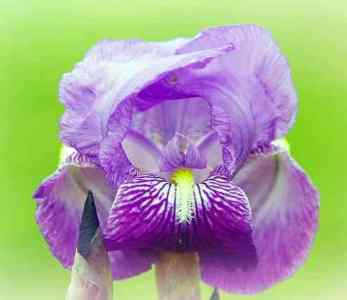
Irises are a pretty type of flowering perennial plant that produces some unusual types of flowers. Irises grow in clumps and have long tall stems with graceful dainty flowers on the end. Some iris varieties (Iris spuria) have long thin or oval petals and other types of iris have wide ruffled colorful petals. Depending on the variety, iris stems can reach between 2 and 5 ft. (60 – 150 cm). Some dwarf irises are especially pretty with grass-like leaves and small purple flowers.
- Outstanding feature: A wide variety of exquisite plants with beautiful flowers that create stunning flower displays.
- Growing zones: 3 – 9.
- Purple iris cultivars: Japanese Iris ‘Frilled Enchantment) (large white ruffled petals with lilac edges), Iris hollandica ‘Blue Magic’ (dark violet petals with bright yellow highlights), Bearded Iris ‘Celebration Song’ (light pink petals fading to lavender-blue colors).
Clematis
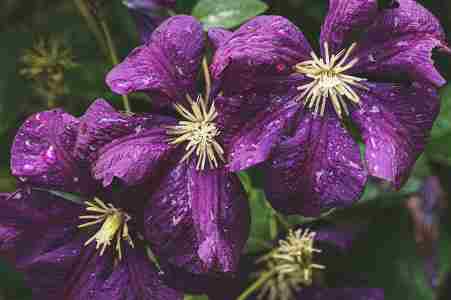
Purple clematis vine
Considered one of the most beautiful flowers in the world, clematis with dark purple flowers is a showpiece. You can decorate your garden with purple flowering Clematis vine plants during the summertime. Clematis belongs to the Ranunculaceae genus which makes them related to buttercups. One of the beauties of climbing plants like clematis is the wide diversity of flower shapes and colors. For example, star-shaped purple flowers with red stripes, papery delicate petals in a bell shape, or showy double blooms that look like pompoms.
- Outstanding feature: Very large flowers that brighten up your garden from early spring until late summer.
- Growing zones: 4 – 10.
- Purple clematis cultivars: Clematis ‘Arabella’ (star-shaped purple flowers with a spiky white center), ‘Blue Dancer’ (delicate light-purple petals and an early bloomer), ‘Diamantina’ (showy blooms with multiples layers of violet frilly petals).
Purple Hyacinth Flowers
Hyacinths (Hyacinthus) produce large clusters of fragrant blossoms in the springtime. The flower blooms are in the shape of a large spike and the plants can grow up to 8” (20 cm) tall. Most types of hyacinth flowers are in pastel shades, with pink, purples, and oranges being the most common varieties.
- Outstanding feature: Beautiful cluster of small flowers in tubular shapes or ones with recurved petals.
- Growing zones: 4 – 8.
- Purple hyacinth cultivars: Hyacinthus orientalis ‘Blue Festival,’ ‘Miss Saigon’ (deep violet fragrant blooms), ‘Purple Sensation.’
Lily of the Nile
Also called African Lilies, Lily of the Nile (Agapanthus praecox) is a popular flowering garden plant for warm climates. The pretty exotic lily of the night flowers look like an explosion of color on the end of tall stems. The tiny purple flowers on these perennials make up globular flowerheads that can grow to around 8” (20 cm) wide. Usually, several flowering stems emerge from a clump of grass-like leaves. Expect to get flowers from the middle of summer until the start of the fall.
- Outstanding feature: Plant them in groups to fill your garden with purple, blue, white, and pink colors.
- Growing zones: 8 – 11.
- Purple Lily of the Nile cultivars: Agapanthus ‘Fireworks’ (with trumpet-like light purple and white flowers), ‘Silver Moon’ (lavender-blue tubular flowers), African Lily ‘Purple Cloud,’ ‘Headbourne Hybrids’ (dark violet-blue star-shaped flowers).
Fuchsia
Extremely popular worldwide, Fuchsia is a type of shrubby plant that is easily identified by its dainty flowers that dangle down from stems. Flowers on fuchsias come in many color combinations such as pink and purple that make them very decorative.
Fuchsia flowers are made up of a few long petals and a contrasting centerpiece. From the middle of fuchsia flowers, long stamens protrude to give the flowers an elegant look. Some fuchsias are double flowers which create showy displays in the summertime. Some interesting combinations are purple and pink, pale pink and lilac, red and mauve, blue and white – to name just a few.
- Outstanding feature: Showy displays of hanging flowers in a multitude of color combinations.
- Growing zones: 8 – 9.
- Purple fuchsia cultivars: Fuchsia ‘Maxima,’ ‘La Campanella,’ ‘Dollar Princess,’ ‘Delta’s Sara,’ ‘Ben Jammin.’
Purple Hydrangea Flowers
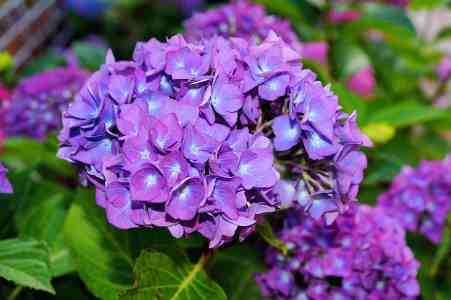
Hydrangeas have blooms in many colors and are a focal point in your garden
Flowering from early spring until late fall, Hydrangeas produce bushy, graceful flowers with large colorful blooms. These perennial ornamental plants are easy to grow and tolerate many conditions. Some of the showiest hydrangea blooms can be up to 8” (20 cm) across. An interesting feature of the blossoms is that some petals are star-shaped, some are oval, and some are multicolored. The bushy colorful hydrangea can grow up to 4 ft. (1.2 m) and have a spread of the same size.
- Outstanding feature: Plant along borders or for ground color if you want large blooms all summer.
- Growing zones: 6 – 9.
- Purple hydrangea cultivars: Hydrangea ‘Merritt’s Supreme’ (dense deep purple mophead), ‘Sumida No Hanabi’ (light purple-blue showy double florets), ‘Hamburg’ (purplish large flowerheads that turn to red).
Foxglove
Foxgloves (Digitalis) plants have some of the most eye-catching purple flowers in your garden. These plants have tall stems containing multiple tubular, trumpet flowers grace these perennial summer plants. Foxgloves blossom spires come in many colors and color combinations. Some of the prettiest types of foxgloves have light purple or mauve petals with darker spots. Foxgloves can grow to between 2 and 5 ft. (60 – 150 cm).
- Outstanding feature: Tall cone-shaped flowers with small bell-like flowers dangling off them.
- Growing zones: 4 – 8.
- Purple foxglove cultivars: Digitalis purpurea ‘Excelsior Group,’ ‘Pam’s Choice.’
Coneflower (Echinacea)
Coneflowers (Echinacea) are easy-to-grow plants that flower in the summer. Clumps of these herbaceous perennials will add various shades of light purple and pink to your summer landscape. The flowers sit on the top of long stems that grow between 1 and 4 ft. (30 – 120 cm). The long florets look like purple rays from a darker spiky ball-shaped center. On some species of this plant, the petals droop down to create a dramatic effect. Echinacea plant is also renowned for its medicinal and healing properties.
- Outstanding feature: Attractive purple flowers that flourish where other plants can’t.
- Growing zones: 3 – 10.
Crocus

Crocus is a bulbous perennial with attractive flowers in various color combinations such as purple, white, and pink
Crocuses are one of the first purple flowers to bloom in springtime. These bulbous perennials are also great for colorful ground cover throughout the winter months. Purple is the most common color of crocus. However, there are also white and yellow varieties. Some of the prettiest purple crocus are the bi- and multi-colored types. Some exquisite examples have light lilac petals and deep orange centers. Crocuses grow to about 4” (10 cm) high.
- Outstanding feature: Some of the most attractive flowers in cold months.
- Growing zones: 3 – 8.
- Purple crocus cultivars: ‘Siber’s’ Crocus, Crocus sativus ‘Saffron,’ ‘Spring Beauty,’ ‘Roseus,’ ‘Whitewell Purple.’
Petunia
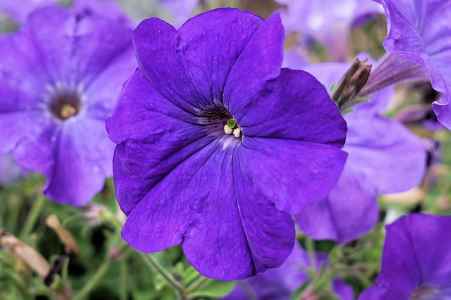
Petunia is an annual flowering plant that comes in many sizes and colors including purple
Petunias are annual flowering plants that produce some beautiful blooms of purple, burgundy, red, creamy white, and yellow flowers. Petunia flowers are identified by their trumpet-like flowers and bushy appearance.
If you plant petunias in your garden, you are guaranteed wonderful floral displays from late spring until the fall.
Petunia flowers also come in varying sizes with some of the largest varieties found in the Grandiflora species. You can also combine different colors of petunias to create spectacular displays.
- Outstanding feature: Pretty blooms of flowers that spread out over the ground. Also great in hanging baskets and containers.
- Growing zones: 2 – 11.
- Purple petunia cultivars: ‘Shock Wave Deep Purple,’ ‘Shock Wave Denim,’ ‘Supertunia Bordeaux,’ ‘Supertunia Mulberry Charm,’ ‘Tidal Wave Purple,’ ‘Supertunia Royal Magenta.’
Speedwells
Also called Veronica, Speedwells are clusters of tiny flowers that look like fuzzy spikes. If hyacinth blooms or snapdragons are too large for you, then Speedwells are a perfect choice. Depending on the cultivar, speedwells can grow to between 10” and 3 ft. (25 cm – 90 cm). Some types of speedwells have a spreading ability and are excellent for floral ground cover. The long colorful slender spikes are also great for cut flower displays.
- Outstanding feature: Bushy clumps of colorful spiky flowers.
- Growing zones: 4 – 8.
- Purple speedwell cultivars: ‘Hocus Pocus,’ ‘Purple Illusion,’ ‘Royal Candles’ (with deep purple-blue fuzzy spikes).
Allium
Some of the prettiest ornamental purple flowers you can grow are from the Allium genus. These plants are flowering onions that make their appearance in late spring or early summer. Large globular purple flowerheads sit proudly on top of long green stems. Some of the larger purple Allium flowers can be up to 10” (25 cm) across. These globe-shaped flowers are made up of densely packed violet flowers in the shape of a star. Flowers can be a dark purple, reddish-purple, or lilac.
- Outstanding feature: Plant along borders for a dramatic look to your garden.
- Growing zones: 4 – 8.
Aster
If you are looking for pretty perennial plants to add a dash of purple color to your summer garden, then choose asters. Flowers on aster plants look like purple rays fanning out from a yellow center. Planting a collection of asters can create a dramatic feature in your garden during the summer. These star-shaped violet flowers are very easy to grow and fill your garden in shades of purple.
- Outstanding feature: Spiky-looking purple, lilac, light blue, and violet flowers.
- Growing zones: 5 – 8.
- Purple aster cultivars: ‘Wood’s Purple,’ ‘Grunder’ (with deep-bluish lavender petals and a yellow center), bushy ‘Sapphire’ asters, ‘Violet Queen,’ ‘Kickin Lilac Blue.’
Related: Discover the most amazing types of asters.
Calla Lily
You can identify Calla Lilies (Zantedeschia) by their chalice-shaped flowers that create a dramatic appearance. Calla lilies are romantic, exotic, and chic all at the same time. Some purple calla lilies are especially stunning with their pure white petals and dark violet centers. Some varieties of purple calla lilies have flowers that are so dark that they are almost black. These summer flowers grow to between 1 and 2 ft. (30 – 60 cm) tall. Calla lilies can be a dramatic centerpiece in a floral arrangement for a celebration.
- Outstanding feature: Stunning trumpet-shaped flowers surrounded by an elegant leaf.
- Growing zones: 8 – 10.
- Purple cultivars: Zantedeschia ‘Odessa,’ ‘Picasso,’ ‘Lavender Gem,’ ‘Night Cap,’
Related articles:
- Stunning Plants with Orange Flowers for Your Garden
- Beautiful Yellow Flowers to Give Stunning Color to Your Garden
- Amazing White Flowers to Give Stunning Color to Your Garden


